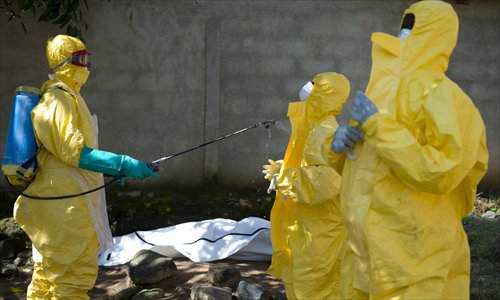Ebola fight far from over
China, other countries stepping up aid

Guinean Red Cross workers prepare to carry the corpse of a victim of Ebola in Macenta on November 21, 2014. Photo: AFP
A December 1 target for limiting the spread of the Ebola virus will not be fully met, announced the UN Ebola Emergency Response Mission on Monday.
The goal set in September sought to have 70 percent of Ebola patients receiving treatment and 70 percent of Ebola victims safely buried. But the number of infections in Sierra Leone remains on the rise, while an Italian doctor who contracted Ebola while working in Sierra Leone has been sent back to Rome for treatment. New cases in Mali are another reminder that no country in the region is immune to the cross-border spread of the disease.
As of November 26, the deadly Ebola crisis had claimed over 5,500 lives across eight countries, out of a total 15,351 cases of infection since late December 2013, according to World Health Organization figures. The WHO said that a total of 570 healthcare workers were known to have contracted the virus, and 324 of them had died. The recent outbreak has primarily affected West African three countries: Guinea, Liberia and Sierra Leone.
Countries have recognized the importance of tackling Ebola at its source in West Africa. Last week, China sent a group of 163 health workers to Liberia, bringing their experience in combating SARS in 2003 to bear on setting up a military hospital. According to the Chinese Ministry of Commerce, China has contributed a total of $122.95 million in aid and has sent 450 public health experts and medical workers to combat the virus.
China is among the countries which have provided the most aid. The US pledged more than $750 million and 3,000 soldiers to combat Ebola, while the UK has invested some £200 million ($315 million), and committed to providing 700 Ebola treatment beds in at least four treatment centers. The German government said it would be providing another 84.7 million euros ($106 million) to fight Ebola, bringing German assistance to over 100 million euros.
Deadly crisis
In the medical journal the Lancet on September 4, Georgetown law professor Lawrence Gostin argued that to avert the Ebola outbreak and prevent the next epidemic, "The answer is not untested drugs, mass quarantines, or even humanitarian relief. If the real reasons the outbreak turned into a tragedy of these proportions are human resource shortages and fragile health systems, the solution is to fix these inherent structural deficiencies."
The effectiveness of national governance in West Africa is worrisome. The current Ebola epidemic started back in March. But local authorities of Liberia, Guinea and Sierra Leone, to varying degrees, concealed the problem. The severity of the Ebola outbreak in West Africa was first brought to the attention of the international community when the first cases appeared outside Africa.
The international community is responsible for neglecting the growing pandemic in Africa in its first four months. But the African countries' procrastination in combating the disease undoubtedly led to wasted opportunities to curb the epidemic at the very beginning.
He Wenping, an expert in African Studies in the Chinese Academy of Social Sciences, told the Global Times, "Years of civil war have left Liberia's economy and health conditions lagging far behind. The country has a serious shortage of medicine, facilities and personnel."
The scale of the current outbreak is the result of decades of underfunded healthcare systems with no governance, a consequence of poverty, war, corruption and political instability, said Michael Edelstein, consultant research fellow of Center on Global Health Security at Chatham House in London.
Widespread mistrust of the government resulted in conspiracy theories. Many believed that governments were intentionally faking the outbreak of Ebola to attract international funds.
This led some to resist monitoring and quarantine, which in turned thwarted efforts to control the disease.
Transportation links were another factor leading to the outbreak's rapid spread. Ebola first appeared in the border area between Guinea, Liberia and Sierra Leone, where the high mobility of the population created favorable conditions for the disease's transmission.
Past outbreaks were stopped while they were still in rural areas, where population densities were lower and people traveled less frequently.
Tough battleground
Apart from assisting West Africa in stopping Ebola at the source, many countries have taken steps to prevent the fatal virus from gaining a foothold on their home soil.
US President Barack Obama appointed Ron Klain to coordinate the administration's global response to the Ebola epidemic, with a mandate to ensure that patients are properly treated without diverting resources from the US' commitment to West Africa. The Pentagon vowed to create a 30-member expeditionary medical support team to provide emergency help in a US domestic Ebola response.
Public Health England rolled out enhanced screening for Ebola starting at big airports like Heathrow, Gatwick and St. Pancras for passengers traveling from Sierra Leone, Guinea and Liberia.
The National Health Service England has launched a national public awareness campaign in a bid to persuade people to seek advice early from their local pharmacist if they are "feeling under the weather."
As public health officials and hospital workers in different countries race to contain a global epidemic, they are also facing the challenge of managing public fear.
"The most successful strategy is to be very clear about what the public health message is and what the risk is. People coming from an affected area don't pose any public health risk. What is important is that these people are assessed for the risk they will develop the disease," Michael Edelstein told the Global Times, adding that if they develop any symptoms and they have to be managed.
Only those exhibiting symptoms of Ebola can pass on the disease.
The virus is transmissible only through direct contact with the bodily fluids of an infected person exhibiting symptoms such as fever or vomiting.